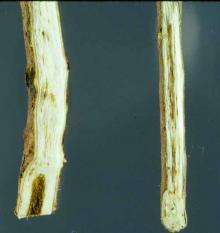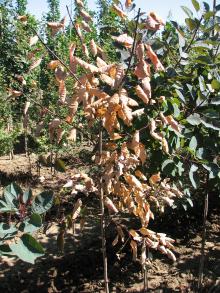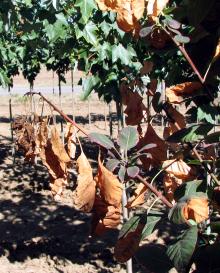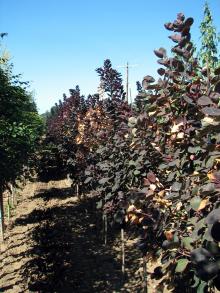Cause Verticillium dahliae, a soilborne fungus that affects many annual and perennial plant species. The fungus produces microsclerotia in the tissues of diseased plants. Microsclerotia are released into the soil as plant tissue decomposes and may persist in soil for many years. The microsclerotia germinate, penetrate roots, and colonize the xylem system. Colonization leads to a decrease in the amount of water able to reach the leaves. Found several times by the OSU Plant Clinic.
Symptoms May occur within a few weeks of planting into infested soil. Leaves become wilted or light brown and appear scorched, sometimes only on one side of the leaf or near the leaf margins. Symptomatic leaves may fall prematurely or hang on dead branches. Branches may wilt at the tips. Sapwood appears discolored with reddish brown streaks, compared to normal sapwood, which is yellowish white. Symptoms may occur on several random branches on a plant or on only one side of a branch. Infected plants may die within a few months. Overall growth may be stunted.
Sampling Soil samples or symptomatic branches and leaves may be sent to any of various private and public laboratories to test for microsclerotia. Nurseries may wish to test individual core samples to determine the distribution in a particular field. The presence of any microsclerotia in the soil should be interpreted as a potential disease risk.
Cultural control
- Use only pathogen-free nursery stock.
- Test soil before planting to select a site with no detectable microsclerotia.
- Avoid planting in fields with a history of Verticillium wilt.
- Preplant soil solarization has been helpful in reducing populations of certain soilborne pathogens and weeds in western Oregon. Place clear plastic (preferably anti-condensation film) directly on smooth, rototilled ground, which has been irrigated to field capacity and then allowed to drain for 1-2 days. Bury the edges of the plastic to trap the heat. Solarize for 4-6 weeks (or longer) during the hottest part of the summer, beginning in early- to mid-July.
- Prune off and burn symptomatic branches.
- Clean pruning equipment after use.
- Replace infected or dead plants with nonsusceptible plants.
Chemical control Preplant soil fumigation may be helpful when grown under nursery conditions.
Reference Wang, Y., Xiao, S., Xiong, D., and Tian, C. 2013. Genetic transformation, infection process and qPCR quantification of Verticillium dahliae on smoke-tree Cotinus coggygria. Australasian Plant Pathology 42:33-41.





